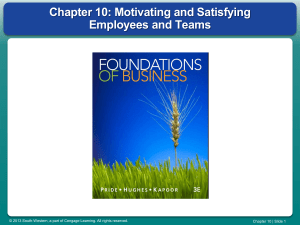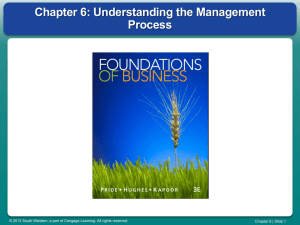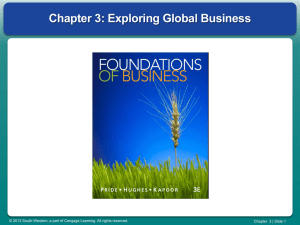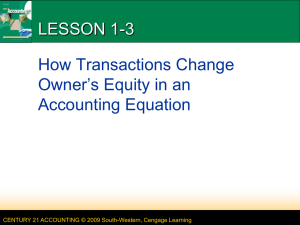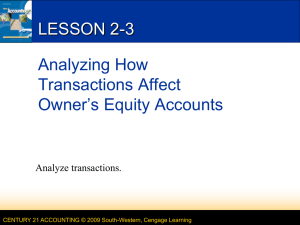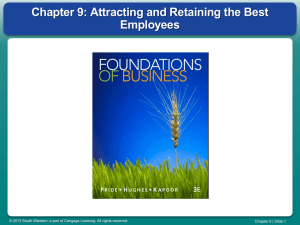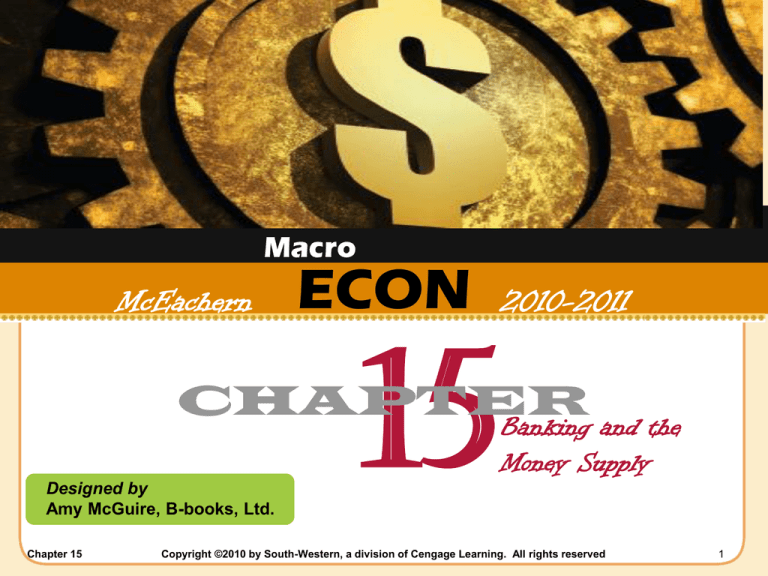
Macro
McEachern
ECON
15
2010-2011
CHAPTER
Banking and the
Money Supply
Designed by
Amy McGuire, B-books, Ltd.
Chapter 15
Copyright ©2010 by South-Western, a division of Cengage Learning. All rights reserved
1
Money Aggregates
LO1
Chapter 15
Money aggregates
Measure of money supply
Defined by the Fed
M1 = Narrow definition of money
Currency (including coins)
Nonbanking public
Checkable deposits
Bank deposits
Write checks to third parties
Traveler’s checks
Copyright ©2010 by South-Western, a division of Cengage Learning. All rights reserved
2
Money Aggregates
Currency = Fiat money
Federal Reserve Notes
U.S. Bureau of Engraving and
Printing
Issued by & Liabilities of
12 Federal Reserve Banks
60% - abroad
Coins
U.S. Mint
LO1
Chapter 15
Copyright ©2010 by South-Western, a division of Cengage Learning. All rights reserved
3
Money Aggregates
M2 = Broader definition of money
M1
Savings deposits
Earn interest; no specific maturity date
Small-denomination time deposits
Certificates of deposits, CDs
Earn interest; specific maturity date
Money market mutual fund accounts
Restrictions
LO1
Chapter 15
Copyright ©2010 by South-Western, a division of Cengage Learning. All rights reserved
4
Measures of the Money Supply
(February 2009)
Exhibit 1
LO1
Chapter 15
Copyright ©2010 by South-Western, a division of Cengage Learning. All rights reserved
5
Money Aggregates
Credit cards
Loan from the card issuer
Repay later
Dispute a charge
Not part of money supply
Debit cards
From checking account
Part of M1
LO1
Chapter 15
Copyright ©2010 by South-Western, a division of Cengage Learning. All rights reserved
6
LO2
How Banks Work
Banks earn profit
Attract deposits from savers
Lend to borrowers
Banks are financial intermediaries
Reduce transaction costs
Cope with asymmetric
information
Reduce risk through
diversification
Chapter 15
Copyright ©2010 by South-Western, a division of Cengage Learning. All rights reserved
7
LO2
Starting a Bank
Home Bank – obtains a charter
Net worth = Owner’s equity
Shares of stock in the bank
Balance sheet
Assets = Liabilities + Net worth
Asset – owned by bank
Physical property
Financial claim
Stock in district Fed
Liabilities – owned by bank
Chapter 15
Copyright ©2010 by South-Western, a division of Cengage Learning. All rights reserved
8
LO2
Exhibit 2
Home Bank’s Balance Sheet
Chapter 15
Copyright ©2010 by South-Western, a division of Cengage Learning. All rights reserved
9
LO2
Exhibit 3
Home Bank’s Balance Sheet After
$1,000,000 Deposit Into Checking Account
Chapter 15
Copyright ©2010 by South-Western, a division of Cengage Learning. All rights reserved
10
LO2
Reserve Accounts
Required reserve
Dollar amount
Must be held in reserve
Required by Fed
Required reserve ratio
Percentage of checkable deposits (10%)
Must be held in reserve
Reserves (Earn no interest)
Cash in bank’s vault
Deposits at the Fed
Excess reserves
Chapter 15
Copyright ©2010 by South-Western, a division of Cengage Learning. All rights reserved
11
LO2
Liquidity vs. Profitability
Liquidity
Ease to convert assets into cash
Safety
Profitability
Federal funds markets
Day-to-day lending and
borrowing
Among banks
Excess reserves on account at
the Fed
Interest: federal funds rate
Chapter 15
Copyright ©2010 by South-Western, a division of Cengage Learning. All rights reserved
12
How Banks Create Money
Creating money through excess
reserves
– Round one
• Fed buys $1,000 U.S.
government bond
– Creates reserves
• Money supply: +$1,000
• Required reserves: +$100
• Excess reserves: +$900
3
LO
Chapter 15
Copyright ©2010 by South-Western, a division of Cengage Learning. All rights reserved
13
LO3
Exhibit 4
Changes in Home Bank’s Balance Sheet
After Fed Buys a $1,000 Bond from
Securities Dealer
Chapter 15
Copyright ©2010 by South-Western, a division of Cengage Learning. All rights reserved
14
How Banks Create Money
Creating money through excess reserves
– Round two
• $900 loan
• Money supply: +$900
• Required reserves: +$90
• Excess reserves: +$810
LO3
Chapter 15
Copyright ©2010 by South-Western, a division of Cengage Learning. All rights reserved
15
LO3
Exhibit 5
Changes in Home Bank’s Balance Sheet
After Lending $900 to You
Chapter 15
Copyright ©2010 by South-Western, a division of Cengage Learning. All rights reserved
16
How Banks Create Money
Creating money through excess reserves
– Round three
• $810 loan
• Money supply: +$810
• Required reserves: +$81
• Excess reserves: +$729
LO3
Chapter 15
Copyright ©2010 by South-Western, a division of Cengage Learning. All rights reserved
17
LO3
Exhibit 6
Changes in Merchants Trust’s Balance
Sheet After Lending $810 to English Major
Chapter 15
Copyright ©2010 by South-Western, a division of Cengage Learning. All rights reserved
18
How Banks Create Money
Creating money through excess reserves
– Round four and beyond
• Excess reserves – new loans
• Required reserves: +10% of new
checkable deposits
– Excess reserve – maximum amount
for loans
– Money supply expansion
LO3
Chapter 15
Copyright ©2010 by South-Western, a division of Cengage Learning. All rights reserved
19
How Banks Create Money
Creating money through excess reserves
A summary of rounds
– Fed: $1,000 injection in fresh reserves
– Increased excess reserves
– Money supply increase: Up to $10,000
• Checkable deposits
– Banking system
• Eliminates excess reserves
– Expand money supply
LO3
Chapter 15
Copyright ©2010 by South-Western, a division of Cengage Learning. All rights reserved
20
LO3
Exhibit 7
Summary of the Money Creation
Resulting from the Fed’s Purchase of
$1,000 U.S. Government Bond
Chapter 15
Copyright ©2010 by South-Western, a division of Cengage Learning. All rights reserved
21
Reserve Requirements
& Money Expansion
Assumptions
– No bank holds excess
reserves
– Borrowed funds don’t
sit idle
– People don’t want to
hold more cash
LO3
Chapter 15
Copyright ©2010 by South-Western, a division of Cengage Learning. All rights reserved
22
Reserve Requirements
& Money Expansion
Required reserve ratio = r
Money multiplier
Simple money multiplier = 1/r
Change in the money supply = Change in
fresh reserves × 1/r
LO3
Chapter 15
Copyright ©2010 by South-Western, a division of Cengage Learning. All rights reserved
23
Limitations of Money
Expansion
Leakages from expansion
– Smaller money multiplier
– Cash – preferred to checking accounts
• People hold money
• Fewer excess reserves
LO3
Chapter 15
Copyright ©2010 by South-Western, a division of Cengage Learning. All rights reserved
24
Multiple Contraction of
Money Supply
The Fed sells a $1,000 bond
– Money supply: -$1,000
– Required reserves: -$900
– Recall loans
– Money supply: -$900
– Required reserves: -$810
– Maximum effect
• Decrease money supply =
Original decrease in reserve
LO3
requirements × 1/r
Chapter 15
Copyright ©2010 by South-Western, a division of Cengage Learning. All rights reserved
25
The Fed’s Tools of
Monetary Control
Open-market operations
– Buy/sell U.S. government bonds
The discount rate
– Interest rate, the Fed
– For loans made to banks
The required reserve ratio
– Minimum fraction of reserves
LO4
Chapter 15
Copyright ©2010 by South-Western, a division of Cengage Learning. All rights reserved
26
Open-Market Operations
Increase money supply
– The Fed buys U.S. bonds
• Open-market purchase
Reduce money supply
– The Fed sells U.S. bonds
• Open-market sale
LO4
Chapter 15
Copyright ©2010 by South-Western, a division of Cengage Learning. All rights reserved
27
Open-Market Operations
Tool of choice for the Fed
Influences bank reserves
Influences federal funds rate
– Interest rate
– Borrowing among banks
– Of excess reserves at the
Fed
LO4
Chapter 15
Copyright ©2010 by South-Western, a division of Cengage Learning. All rights reserved
28
The Discount Rate
Discount rate
– Interest rate charged by the Fed
– Loans to banks
Bank borrow ‘Discount window’
– Satisfy reserve requirements
The Fed
– Lender of last resort
LO4
Chapter 15
Copyright ©2010 by South-Western, a division of Cengage Learning. All rights reserved
29
The Discount Rate
Primary discount rate
Secondary discount rate
Signal to financial markets
– Monetary policy
Emergency tool
– Injecting liquidity
LO4
Chapter 15
Copyright ©2010 by South-Western, a division of Cengage Learning. All rights reserved
30
Reserve Requirements
Required reserve ratio
Money creation for each dollar of
fresh reserves
Disruptive
– Banking system
LO4
Chapter 15
Copyright ©2010 by South-Western, a division of Cengage Learning. All rights reserved
31
Coping with Financial Crisis
Regulation of financial markets
Prevents major disruptions and
financial panics
Sufficient liquidity
– Financial system
LO4
Chapter 15
Copyright ©2010 by South-Western, a division of Cengage Learning. All rights reserved
32
The Fed Is a Money Machine
Assets
– U.S. government bonds, 24%
– Earns interest
Liabilities
– Federal Reserve notes, 43%
– Fed pays no interest
The Fed is a money machine
– Supplies Federal Reserve notes
– Main asset: earns interest
LO4 – Main liability: no interest payment
Chapter 15
Copyright ©2010 by South-Western, a division of Cengage Learning. All rights reserved
33
LO4
Exhibit 8
Federal Reserve Bank Balance Sheet as of
April 1, 2009 (Billions)
Chapter 15
Copyright ©2010 by South-Western, a division of Cengage Learning. All rights reserved
34

